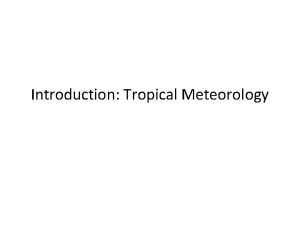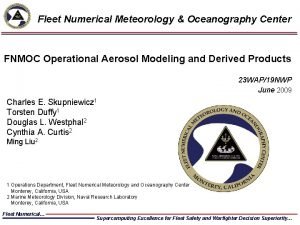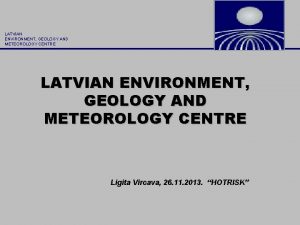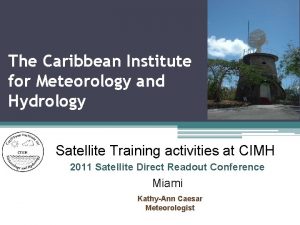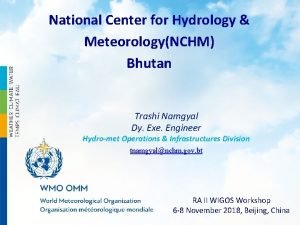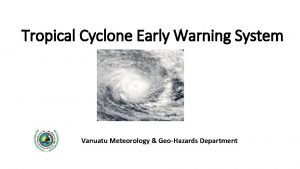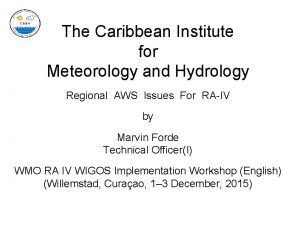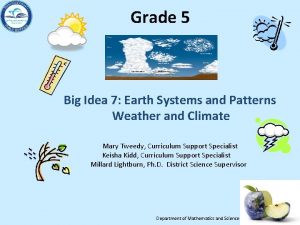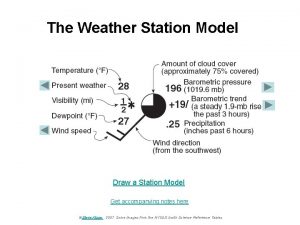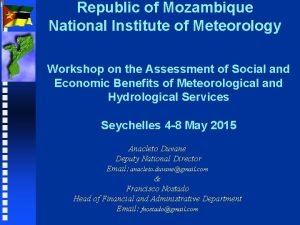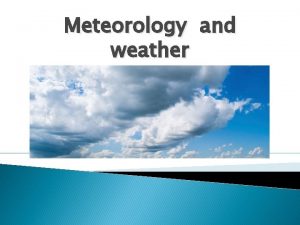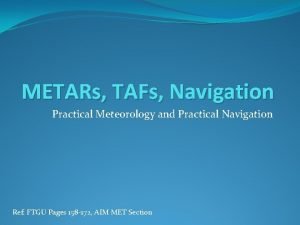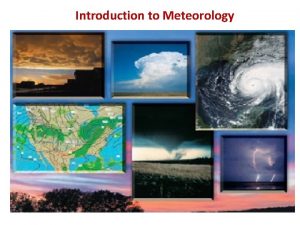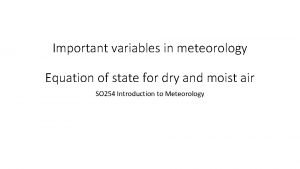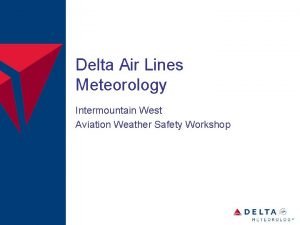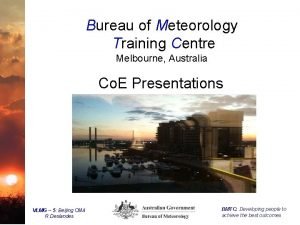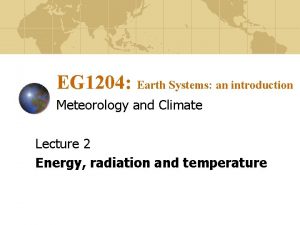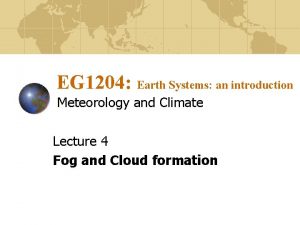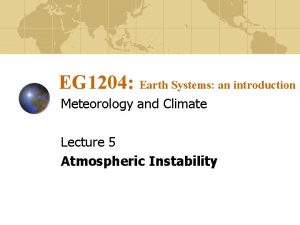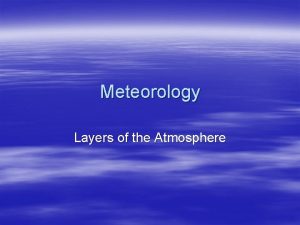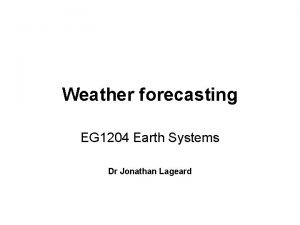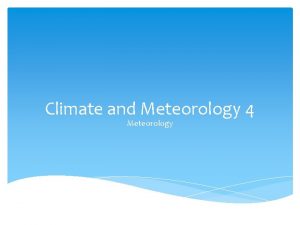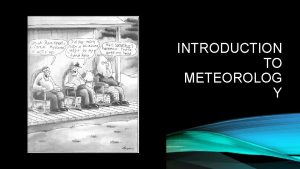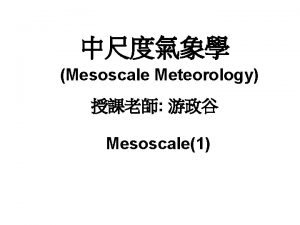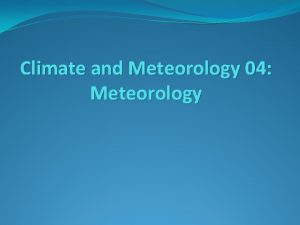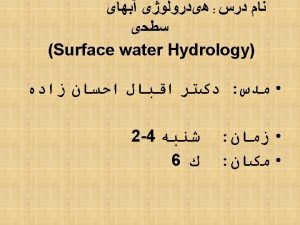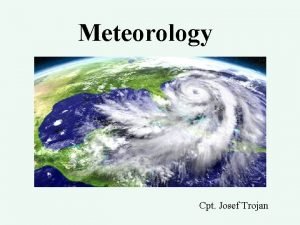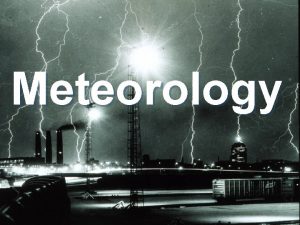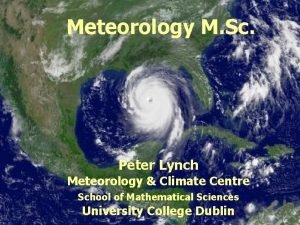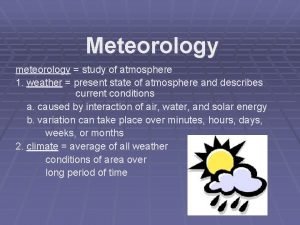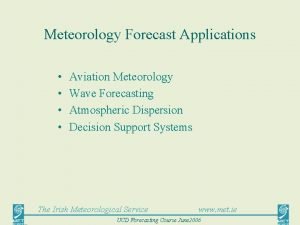EG 1204 Earth Systems an introduction Meteorology and























- Slides: 23

EG 1204: Earth Systems: an introduction Meteorology and Climate Dr Mark Cresswell Structure of the atmosphere & ocea

Topics we will cover • • Introduction to lecture series & basic Astronomy Composition of the atmosphere Vertical structure of the atmosphere Relationships between pressure, temperature and height • Introduction to the oceans • Structure of the oceans • Characteristics of oceans and circulation

Suggested References #1 Text Books: • Ahrens, C. Donald. (2000) Meteorology today : an introduction to weather, climate, and the environment. • Harvey, Danny. (2000) Climate and global environmental change • Burroughs, William James. (2001) Climate change : a multidisciplinary approach. • Climate change 2001 : The scientific basis / edited by J. T. Houghton • Mc. Guffie K and Henderson-Sellers A. (1997). A climate modelling primer. Published by John Wiley, England.

Suggested References #2 Scientific Journals: • Quarterly Journal of the Royal Meteorological Society • Monthly Weather Review • Meteorological Applications • Journal of Climatology

Suggested References #3 Internet: • KNMI climate explorer: – http: //climexp. knmi. nl • Royal Meteorological Society: – http: //www. royal-met-soc. org. uk/ • The Met. Office: – http: //www. meto. gov. uk/ • NOAA-ENSO: – http: //nsipp. gsfc. nasa. gov/enso/

General Points • The atmosphere behaves like a fluid • The atmosphere is a mixture of different gases, aerosols and particles • The atmosphere remains around the earth as an envelope because of gravity • Much of the observed motion in the atmosphere results from solar radiation

Basic Astronomy • For most of the Earth, energy varies on daily (diurnal) and seasonal (annual) time-scales. • Changes from daytime to night and progression through the four seasons depends on the configuration of the Earth-Sun orbit

Basic Astronomy • The Earth completes a single rotation about its axis in approx 24 hours (23. 9345 hours!) - this period is known as a day

Basic Astronomy • The Earth completes a single revolution around the Sun in approx 365 days (365. 256 days) - period is known as a year

Basic Astronomy • Axis about which the earth rotates tilts Spring Summer Winter Autumn

Composition of the atmosphere


Vertical structure of the atmosphere • Weight is the mass of an object multiplied by the acceleration of gravity Weight = mass x gravity • An object’s mass is the quantity of matter in the object

Vertical structure of the atmosphere • The density of air is determined by the mass of molecules and the amount of space between them Density = mass/volume • Density tells us how much matter is in a given space (or volume)

Vertical structure of the atmosphere • Each time an air molecule bounces against an object it gives a tiny push • This small pushing force divided by the area on which it pushes is called pressure Pressure = force/area

Vertical structure of the atmosphere • In meteorology we discuss air pressure in units of hectopascals (h. Pa) (previously called millibars mb) • The average atmospheric pressure at the Earth surface is 1013. 25 h. Pa • We can sense sudden changes in pressure when our ears ‘pop’ such as that experienced in old aircraft

Relationship between pressure and height • As we climb in elevation (up a mountain or in a hot air balloon) fewer air molecules are above us: atmospheric pressure always decreases with increasing height


Relationship between temperature and height


Introduction to the Oceans • The oceans occupy 71% of the earth’s surface • Over 60% of global ocean surface is in the southern hemisphere • Three quarters of the ocean area is between 3, 000 and 6, 000 metres deep

Structure of the Oceans • The thermocline is a layer characterised by decreasing temperature and increasing density with depth • The thermocline is stratified and inhibits vertical mixing

Structure of the Oceans • Below thermocline layer is the deep layer of cold, dense water • Deep layer motion is mostly driven by density variations due to salinity change
 Schindler aufzüge vollwartung
Schindler aufzüge vollwartung Introduction to tropical meteorology
Introduction to tropical meteorology Introduction to tropical meteorology
Introduction to tropical meteorology Meteorology hydrology and water management
Meteorology hydrology and water management Fleet numerical meteorology and oceanography center
Fleet numerical meteorology and oceanography center Latvian environment geology and meteorology centre
Latvian environment geology and meteorology centre Caribbean weather satellite
Caribbean weather satellite National center for hydrology and meteorology
National center for hydrology and meteorology Vanuatu meteo cyclone warning
Vanuatu meteo cyclone warning Caribbean institute for meteorology and hydrology
Caribbean institute for meteorology and hydrology Big idea 7 earth systems and patterns
Big idea 7 earth systems and patterns Big idea 7 earth systems and patterns
Big idea 7 earth systems and patterns How to make a station model
How to make a station model Cisk meteorology
Cisk meteorology National institute of meteorology
National institute of meteorology Penn state department of meteorology
Penn state department of meteorology Study of weather
Study of weather Metar format
Metar format Meteorology definition
Meteorology definition Equation of state for dry air
Equation of state for dry air Delta meteorology
Delta meteorology Meteorology courses melbourne
Meteorology courses melbourne Cin meteorology
Cin meteorology Weather symbols chart
Weather symbols chart

